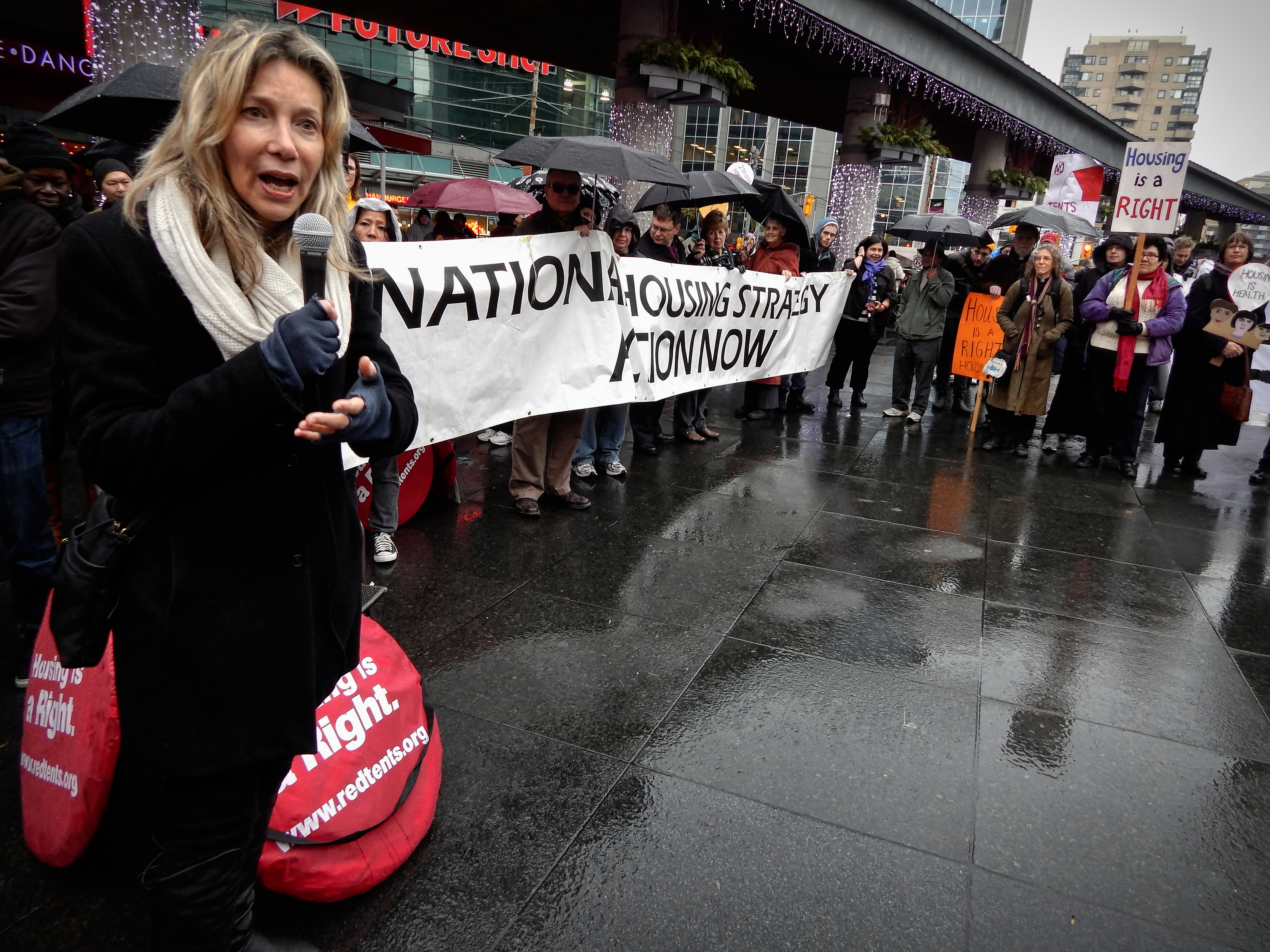Three demands.
The same ones housing activists have been calling for since the federal government axed the national housing program two decades ago.
To ensure that the 600,000 households currently living in social housing across the country continue to receive their social housing subsidies.
“We can’t let those people lose that subsidy because they’re going to face rent that they can’t afford and be pushed out of their homes,” said Yutaka Dirks, Advocacy Centre for Tenants Ontario.
To increase the amount of money the federal government spends on building new social housing and homelessness programs.
And to develop a national housing strategy.
“We need a plan funded by the federal government to end homelessness in Canada because housing is a right,” said Dirks at the Toronto National Housing Day rally in Dundas Square organized by the Right to Housing Coalition Ontario, a group comprised of people facing homelessness, advocates, service providers and organizations.
A fundamental right that’s a key determinant of a person’s overall health, happiness and well-being.
“Everything else flows from housing,” said Harvey Cooper, Co-op Housing Federation. “Your health, whether you can hold on to a job, whether your kids have a place to study.”
Yet for many, a decent, affordable, safe place to live has become nothing more than a pipe dream.
“We know in this city and cities across the country, (affordable housing) waiting lists are just spiralling,” said Cooper. “Because the (market rental) housing that does exist is far too expensive.”
Skyrocketing rents and an ever-present fear that the existing social housing will slowly disappear had Cooper sounding alarm bells.
“Because there’s a great danger that we may lose some of that stock,” he said.
It’s hard to believe that could happen in a country, where in 1946, the Central Mortgage and Housing Corporation was established to administer the National Housing Act and the Home Improvement Loans Guarantee Act.
In 1979, the name was changed to the Canada Mortgage and Housing Corporation (CMHC).
“Toward the end of the 1940s, the federal government embarked on a program of much-needed social and rental housing, creating a federal-provincial public housing program for low-income families, with costs and subsidies shared 75% by the federal government and 25% by the province,” said the CMHC on its website.
“In the 1950s the federal government provided grants to cities to encourage them to tear down derelict buildings and build municipally owned housing corporations. Regent Park in Toronto is the first urban renewal project, where 42 acres are cleared to build the 1056-unit, low-rent housing development in 1950.
“During the 1960s, CMHC built the first co-operative housing and, for the first time in Canadian history, multi-unit apartment buildings were beginning to outpace housing starts for single family homes.”
Citizens for Public Justice said on its website that “during the 1970s, Canada created successful national programs to provide affordable housing units and combat homelessness.”
But in 1993, Canada’s National Affordable Housing Program was axed by the Liberals.
“One of the most affluent countries in the world,” said Doris Grinspun, Registered Nurses’ Association of Ontario (RNAO).
A 2007 report issued by journalist and author Gordon Laird said that Canada’s homeless population was somewhere between 200,000 and 300,000 people, while another 1.7 million residents struggled to keep a roof over their heads.
In Ontario, almost 160,000 households, including 72,700 in Toronto, were waiting for affordable homes as of December 2012, according to the Ontario Non-Profit Housing Association’s annual waiting list survey.
Average wait times in Ontario vary from 0.5 to 8.45 years. In Toronto, the average wait time is five years.
“Being homeless means we die earlier,” said Grinspun.
According to a 2009 report published by Charity Intelligence Canada, the average life expectancy of a homeless person in Canada is 39 years.
Given the harsh life, it’s not hard to understand why.
“Thousands of people wake up each day in a run-down apartment, in a hostel bed or with strangers sleeping a metre away,” said Colin Johnson, Anglican Archbishop of Toronto.
“Or else their home is a bench, a heating grate or under a bridge.”
With their only nourishment coming from meal programs or food banks. “They help people through the day,” said Johnson. “With little more.”
That’s why they gathered on a rainy late November day in Dundas Square, demanding all levels of government work in harmony to end the housing crisis.
“It’s really shameful that we still have to gather under these conditions year after year to ask for something that should be a basic human right,” said Emily Paradis, University of Toronto.
A researcher at U of T, Paradis was part of a team that released a report Friday morning showing that nine out of ten families with children housed in rental high-rise apartments in Toronto live in inadequate housing and are at risk of homelessness.
“And those buildings house about half of Toronto’s renters.”
Renters like Patricia Moore.
Moore lives in Thorncliffe Park where she said 10 to 12 people live in two-bedroom apartments, six people in one-bedroom apartments.
A one-bedroom unit rents for $1,100 a month plus hydro, a two-bedroom $1,248 plus hydro and a three-bedroom $1,500 plus hydro.
“Why can’t we have (affordable) housing the same way that we have condominiums?” asked Moore.
If federal NDP Toronto Centre candidate Linda McQuaig had her way, Moore would see more affordable housing starts in her neighbourhood, across the rest of the city and throughout the country.
“Killing the National Housing program was a terrible mistake that really contributed to the explosion of homelessness we’ve seen and the general deepening of poverty,” said McQuaig in an interview prior to the rally.
“You’ve got hundreds of thousands of people across the country that are potentially going to be without a home. That’s a disastrous situation.”




